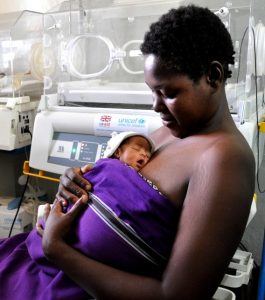Prematurity is one of the leading causes of neonatal mortality in Kenya. Approximately 188,000 babies in Kenya are born too soon. Health workforce shortage, limited skills and lack of infrastructure including appropriate equipment, commodities and space* pose challenges to managing preterm births. Where equipment is available, it is often inadequate and poorly maintained. Lack of a reliable power source in most health facilities means that the equipment’s functionality is compromised and less effective. Available evidence indicates that scaling up low-cost, high-impact interventions can reduce morbidity and mortality from prematurity.
Implementing kangaroo mother care in a high-burden county
It is against this background that UNICEF, with funding from the United Kingdom government, has supported the Ministry of Health in Kenya to roll out kangaroo mother care (KMC) in high-burden counties (districts). KMC involves prolonged continuous skin-to-skin contact between a mother or her surrogate and her preterm or low birth weight infant. For stable preterm infants, this low-cost, high-impact intervention has been shown to offer better thermal regulation and greater health benefits compared to conventional care (incubators). At national level, UNICEF in collaboration with other partners has supported the Ministry of Health in the development of KMC operational guidelines and policy review. In Kakamega County in Western Kenya Region, the intervention has been implemented in 25 high-volume health facilities.

UNICEF supported the Department of Health to train 40 midwives in a three-day skills-based workshop. The midwives learned theoretical components of KMC, including the establishment of KMC at health facilities, initiating and maintaining KMC, KMC nutrition, physical and emotional support, monitoring and evaluation and essential elements for scale-up. This was then followed by practical sessions in a newborn unit at one of the referral hospitals in the region. UNICEF and the Department of Health then supported the midwives in implementing KMC at their respective health facilities including provision of KMC beds, digital weighing scales, guidelines and supportive supervision. The health workers had initially received essential newborn care training.
A year-and-a-half later, KMC is now being practiced in all the targeted health facilities in the County and has yielded substantial results. Based on health facility registers and program data, 300 preterm infants have benefited from the intervention so far with newborn deaths reducing by as much as 67% at one of the facilities, with average reduction across the 25 facilities standing at 52%. In addition, some of the benefits of KMC have gone beyond the newborns. For instance, mothers at one of the health facilities have now formed a KMC club, a mother support group that meets on a monthly basis to discuss issues affecting their health as well as that of their children, including family planning, breastfeeding and immunization.
Lessons learned
The introduction of KMC in Kakamega has offered a number of lessons. Key among these is that implementation of KMC will need to be facilitated by supportive health authorities at County level and in all health facilities. Secondly, KMC does not require additional staff at the health facility, neither does it require significant resources to start. Many of the 25 health facilities in Kakamega started off in a small room with a single improvised KMC bed and managed the service as part of the newborn unit. Continued supervision and mentorship from UNICEF field staff has ensured that the health workers are motivated and keep building on their knowledge and skills so they can support other health facilities to introduce the intervention.
—
*Ministry of Health, Kenya. KANGAROO MOTHER CARE: Clinical Implementation Guidelines 2016
Photo Credit: Dan Oloo, Communication Specialist, UNICEF Kenya, 2017
Learn more about kangaroo mother care
Join the conversation on International Kangaroo Care Awareness Day (15 May) using #KangarooCareDay
